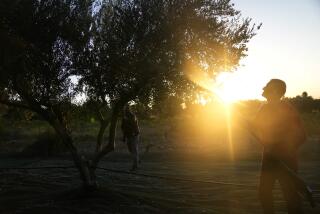Desert Conditions Feared : Threat Seen to Spain’s Coast, Farmland
- Share via
MADRID — Greedy farmers, hungry goats and uncontrolled fires threaten to turn the Mediterranean coast and the farmlands of Spain into desert, according to a leading environmentalist.
A full quarter of Spain, including the Costa del Sol and the hinterland, a tourist paradise that includes some of the country’s richest fruit and vegetable land, is in danger, according to the head of the government environment agency.
“Twelve million hectares (30 million acres), or one-fourth of the country, are affected by severe erosion that could turn them into a desert unless it is checked,” said Santiago Marraco, director of the Institute for Preservation of Nature (ICONA).
He said that half of Spain is in a fragile equilibrium, and only a quarter is unaffected.
Long-Term Problem
A highly placed government official, who declined to be identified, said that so-called “desertification” was one of the worst long-term problems facing the country and its lucrative agriculture.
Marraco dismissed speculation that desertification could be linked to spectacular changes in weather patterns.
“This is not the Sahara Desert moving north,” he said.
He pointed at more common culprits: greedy peasants over-farming, goats grazing the land barren, careless tourists starting forest fires. All were contributing to deforestation, the main cause of erosion that turns fertile soil into sand and stones.
Yellowing Grass
Once upon a time, the legend goes, squirrels hopped across the country from tree to tree without ever touching the ground.
Now travelers in many parts of central and southern Spain marvel at vast horizons of bush and yellowing grass where few trees offer shelter from the burning sun.
Unlike central and northern Europe’s tall trees, the most common trees in Spain are small oaks, which bring little income to their owners. Farmers started burning them down many centuries ago for charcoal or to make way for pastures.
“They believed that what they burnt down was worthless,” Marraco said.
But unknowingly, they rid their land of its protective cover, making it prey to violent Mediterranean downpours that wash away the soil.
Downward Spiral
Without the oaks, the land can support only more simple trees, such as pines. When the pines are burned down, the land can support only bush. If the bush is burned or grazed by goats, it turns into short grass, Marraco explained. The next stage is a barren landscape of sand and stones.
To grow oaks again, one has to go back through each stage. And that takes 400 years, Marraco said.
Modern times have altered the problem. A farmers’ exodus to the cities over the last decade is leaving unattended land prey to devastating forest fires, often caused by careless tourists.
“When there were people on the land, they maintained paths that acted as firebreaks. And there were people around to put out blazes,” he said.
Intensive Farming
Tractors and intensive farming forgetful of the age-old tradition of letting soil lie fallow every other year have also helped weaken the land.
With thin soil unable to retain water, rich agricultural areas near the eastern towns of Valencia, Alicante and Murcia have been devastated by disastrous floods over the last few years.
“The worst problem lies now where industrial farming is highly concentrated on the little soil that is left,” Marraco said.
The southern province of Almeria, where booming farming under plastic sheets is yielding several crops of vegetables and tropical fruits a year, was among the most threatened areas.
White Desert
Expensive but careless artificial irrigation brought the land’s salt to the surface, spectacularly turning land into an irreversible white desert.
“With a costly investment, you just destroy wealth,” Marraco said.
He said Spain was spending more than $180 million a year studying erosion and trying to stop it.
ICONA was growing new trees, cutting firebreaks through forests, digging steps on hillsides to prevent the rain washing soil down and planting windbreak rows of trees to stop it being blown away.
50-Year Process
But this was not enough, and there were plans to double spending within five years.
“We calculate that by increasing the investment twofold, we could manage to control erosion within 40 to 50 years,” he said.
The European Community had become increasingly aware of a problem also affecting Italy and Greece, he added. But money was still not forthcoming, and Community funds to tackle erosion in Spain represented only about $55 million a year over the next five years.
More to Read
Sign up for Essential California
The most important California stories and recommendations in your inbox every morning.
You may occasionally receive promotional content from the Los Angeles Times.












